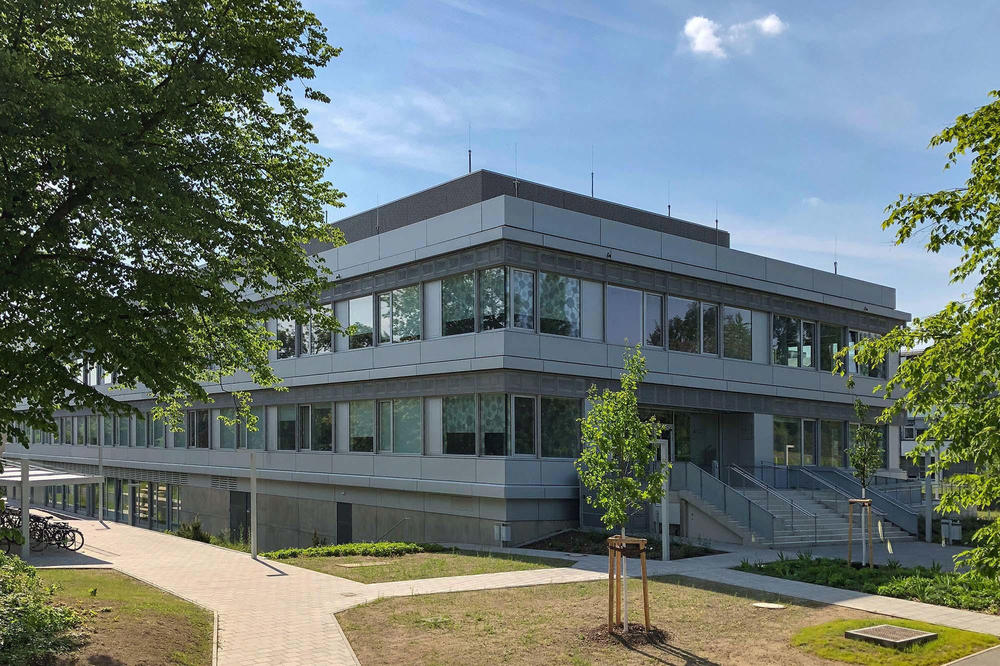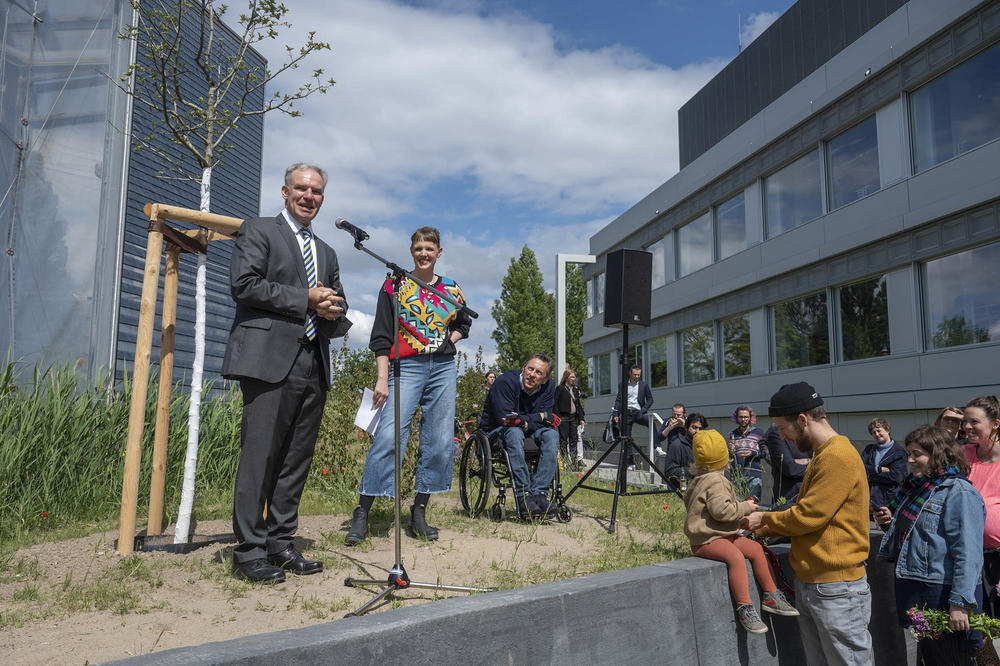A Research Building Dedicated to the Study of Cell Boundaries on the Nanoscale Level
The new SupraFAB Building on the Freie Universität Berlin campus will house research on the properties and functional mechanisms of supramolecular structures at biointerfaces
Aug 22, 2022
The SupraFAB research building received around 48 million euros for construction costs, large equipment, and major instrumentation from the Joint Science Conference (GWK), an institution that links federal and state government activities in Germany.
Image Credit: Bernd Wannenmacher
“The thing I’m looking forward to most is being around and interacting with people from many different research areas,” says Stephanie Reich, a physics professor at Freie Universität. Reich and part of her working group on experimental solid state physics are some of the researchers who will be moving into the SupraFAB Building. The recently finished building on Altensteinstraße 23a can accommodate around 120 researchers with ample office space and laboratory workspaces.
She is also excited that her research equipment will be installed there. “The renovations being done on the Chemistry Building on Takustraße have been a challenge. The drilling and hammering cause the ground to shake, which interferes with our measurements. We won’t have that problem in the new building,” she says. SupraFAB stands on a low-vibration, one-meter-thick floor slab. A forty-ton special foundation that rests on air springs provides additional vibration decoupling, which is required when using sensitive research instruments.
Anyone who wants to study biomolecular structures at the nanoscale level needs large-scale equipment. Other large-scale research facilities at the SupraFAB include super-resolution optical microscopes (for example, a STED microscope), spatially resolved infrared spectrometers (sSNOM), and one of Germany’s few near ambient pressure X-ray photoelectron spectrometers (NAP-XPS) for the investigation of biomolecular structures near normal pressure. Researchers will soon also have access to a 300-kilovolt cryo-transmission electron microscope, which can be used to study atomically resolved structures frozen in an aqueous environment.
A low-temperature scanning tunneling microscope (LT-STM-AFM) with laser coupling was already on display for visitors at the grand opening. The microscope can achieve an incredibly high resolution thanks to the inverse piezoelectric effect created by the scanning tunneling probe. This makes it possible to render visible nanoscale changes on surfaces and study their properties.
How Do Viruses Behave on Cell Surfaces?
The purpose of the large-scale equipment is to enable research on processes that take place at biointerfaces, which include structures like cell membranes that separate and protect the inside of our cells from the outside environment. If a pathogen, like a virus for example, tries to penetrate a cell, the cell’s surface begins to respond with proteins in a complex process that ultimately determines how sick we’ll become.
By combining time-resolved microscopic and spectroscopic methods, novel possibilities emerge that allow scientists to learn more about the kinetic processes of supramolecular architectures at interfaces.
The research topic is currently receiving a lot of attention because around sixty percent of all commercial medications rely on membrane proteins. In the laboratories at SupraFAB, researchers will examine how interactions between viruses and cells can be blocked and how this information can be used to inform decisions regarding diagnostics and treatment. Other researchers in the building will be investigating how nerve cells transmit signals and the role hydrogels play in biointerfaces.
“We want SupraFAB to be a place where we can experience what has connected us scientifically for a long time: Across four Collaborative Research Centers, a Research Training Group, and the Nanoscale Focus Area, we work together intensively as biologists, chemists, and physicists, while also making connections with other disciplines,” says chemistry professor Rainer Haag, who is also the spokesperson for the research building. “Now we have the optimal environment in which to combine our research methods, overcome the challenges posed by the study of biointerfaces and supramolecular architectures, and develop new ideas.
Professor Günter M. Ziegler, president of Freie Universität Berlin, emphasized the complexity inherent to the study of life in his speech at the grand opening, noting that it requires multiple perspectives to answer scientific questions about life. According to Ziegler, it isn’t always easy to think beyond the borders of one’s own discipline because the objects of study, methods, and expected results are so multifaceted. “And yet, we must find ways to forge connections,” he said. “The interdisciplinary Collaborative Research Centers have already shown us that it is possible.”
SupraSwing: Feeling a Pendulum’s Force Firsthand
The art installation “SupraSwing – Swinging for Research,” an artwork created by Katja Marie Vogt and designed to be incorporated into the building plans, contributes to the lively exchange between disciplines. The bright yellow steel structure supports three swings connected as coupled pendulums. It is located on the northwest side of the building, and people were invited to try it out as part of the grand opening festivities.
The first trio to swing on the interactive artwork were former provost of Freie Universität Berlin, Peter Lange, who in 2014 played an important role in advancing the grant for the building project, Stephanie Reich, and Rainer Haag. Haag sees the swings as more than just a fun way to take a break with others during a stressful day of research, they are also a perfect symbol for what the building represents. “We enthusiastically backed Katja Marie Vogt’s proposal from the beginning of the competitive selection process,” Haag says, “and we’re delighted that her idea won out in the end and resulted in this piece.”
Professor Rainer Haag (left) praised the lively exchange between disciplines, noting in particular the art installation “SupraSwing – Swinging for Research,” an artwork created by Katja Marie Vogt (right) that was incorporated into the building plan.
Image Credit: Bernd Wannenmacher
Three Research Fields Combine with Dynamic Results
In Vogt’s speech at the grand opening, she noted that it took a lot of patience and a big push as a group to complete the project. According to Vogt, the artwork is truly pioneering. Many people were involved in the process – a playground inspector even had to sign off on the construction before it could be used.
Vogt’s inspiration came from three distinct sources: the building’s unique foundation that reduces vibrations from the outside world, the collaboration between the disciplines of biology, chemistry, and physics, and, finally, the way processes get “into the swing of things and produce a special group dynamic when multiple people get involved. “While I was researching for the project, I came across the concept of the coupled pendulum and its physical properties. When one pendulum begins to swing, the others can no longer move independently. They exchange energy back and forth. This interdependency can hamper movement, but it can also create a swell of energy – a big push. Swinging on a swing has its ups and downs, just like working together in a group. Here, you experience thrilling moments of discovery mixed with periods of sluggish inactivity.”
Vogt invited researchers from the three disciplines, as well as anyone else who wanted to, to experience the dynamic pendulum effect of the SupraSwing firsthand. In the atrium of the new building, there is a model of the swing that demonstrates the effect clearly, highlighting the purity of the physics behind the idea.
This article originally appeared in German on June 7, 2022, in campus.leben, the online magazine of Freie Universität Berlin.
Further Information
- Website: SupraFAB’s profile and research areas (in German)


